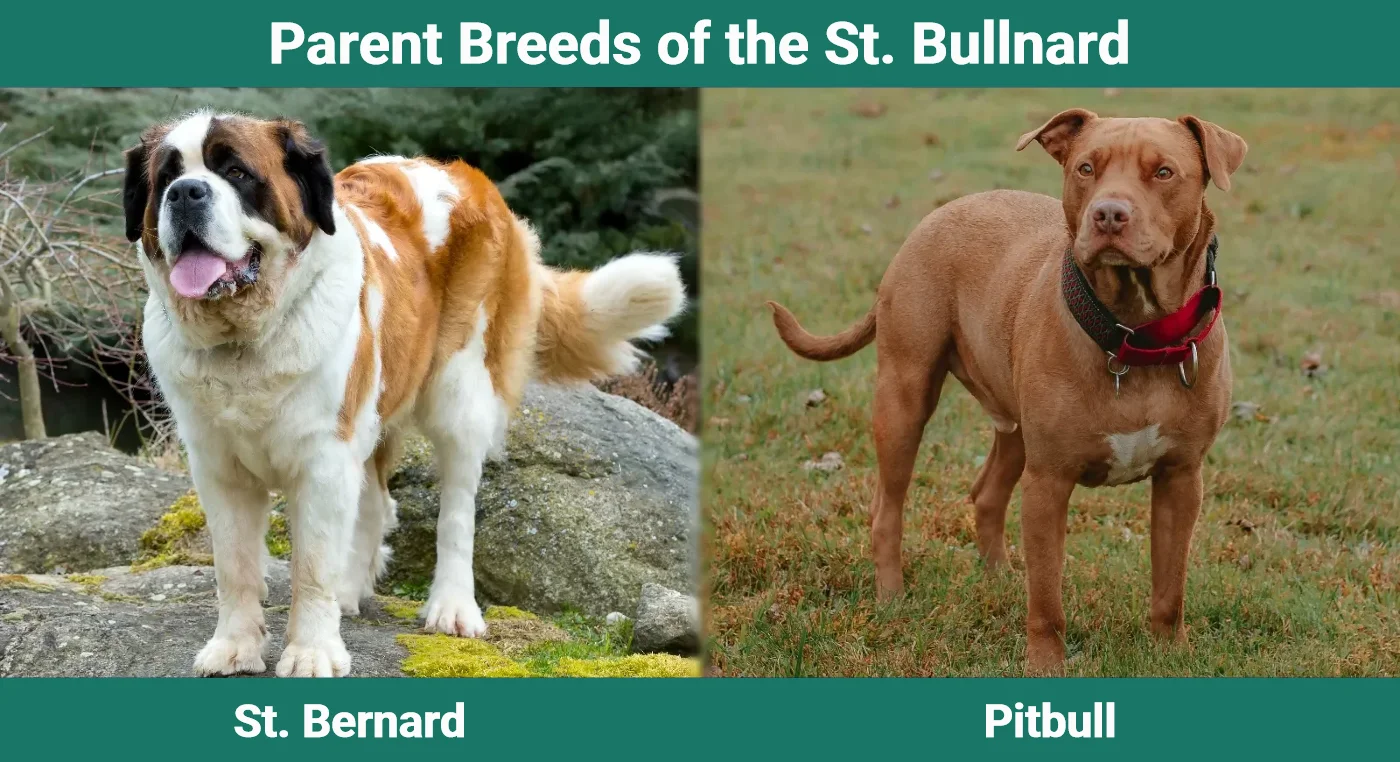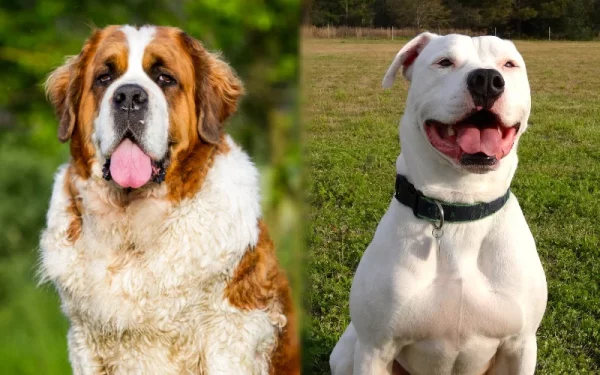Click Below to Skip Ahead
Designer dogs, or hybrids, have become quite popular over the last few years. In case you’re unfamiliar, designer dogs are not purebred dogs but rather a mix of two purebred dogs. The typical goal is to mix two extraordinary dogs with outstanding characteristics and traits to produce one, exceptional dog—one of which is the St. Bullnard. These dogs are a mix of a St. Bernard and a Pitbull. Let’s learn all about this fascinating hybrid dog.
Breed Overview
Height:
20–27 inches
Weight:
50–120 pounds
Lifespan:
8–11 years
Colors:
Brown, black, tan, fawn, white, brindle, red, blue
Suitable for:
Active families, those wanting a large dog, those wanting a watchdog
Temperament:
Loyal, loving, intelligent, protective, easy to train, friendly, brave, playful
The St. Bullnard is a mix of the St. Bernard and the Pitbull. These dogs are big and powerful and make excellent watchdogs. They are loving and loyal to their families and, given their intelligence, not too difficult to train. They have muscular bodies, strong legs, and a deep chest. The St. Bullnard is not aggressive, but they are protective of their humans and will bark if something is not right. They do require early socialization, so keep this in mind in case you are considering adding one to your family.

Saint Bullnard Puppies
The St. Bullnard is not as popular as other hybrids, and if you’re in the market for a St. Bullnard, you’ll be hard-pressed to find one. There are not many breeders out there, and if you find one, the price will likely be steep. You can always check your local animal shelter for one; you never know what type of dog will end up in a shelter for various reasons, and you may just get lucky.
If you do find a puppy, early socialization is key for your St. Bullnard to become a well-behaved doggie. You’ll want to expose your St. Bullnard puppy to other pets and children, teach boundaries, and how to play nicely, especially if you have children in the home. St. Bullnards are not aggressive, but they are large dogs and could accidentally knock a small child over.

Temperament & Intelligence of the Saint Bullnard
Both the St. Bernard and the Pitbull have excellent traits and characteristics, but it’s hard to pinpoint which traits and characteristics one will have when it comes to hybrids. Luckily, both dog breeds are similar regarding temperament and intelligence.
Let’s discuss Pitbulls for a moment. These dogs have a bad reputation and are often labeled as aggressive. Pitbulls are not naturally aggressive, contrary to popular belief. Pitbulls are victims of fighting rings and other illegal events that make them aggressive—it’s the owner and not the dog that’s the problem. So, if you’re concerned about St. Bullnard having a Pitbull in the mix, don’t be.
Both dog breeds are intelligent, so you can be sure that your St. Bullnard will be intelligent too. They are friendly, docile, and love being around their humans.
Are These Dogs Good for Families?🏡
These dogs are good-natured, friendly, and love to be with their human families. They are eager to please and relatively easy to train due to their intelligence. They are strong, however, and you must have the physical strength to control them if need be. When it comes to children, remember that they are powerful dogs, and supervising children during playtime is advised.
Does This Breed Get Along with Other Pets?🐶 😽
The St. Bernard is a little more tolerable with other pets than Pitbulls. However, Pitbulls get along just fine with other dogs as long as they are socialized at an early age. The key, just like with any dog, will require early socialization to be well-behaved.
If you have small pets in the home, such as a cat, hamster, guinea pig, lizard, etc., it’s advised not to let the St. Bullnard around them unsupervised. These dogs have a strong prey drive and may regard the pet as prey.

Things to Know When Owning a Saint Bullnard:
There are quite a few things to consider before adding a new doggie to your family, such as dietary needs, exercise requirements, grooming, and more. In this next section, we’ll cover such topics to help you decide if a St. Bullnard dog is right for you.
Food & Diet Requirements🦴
Your St. Bullnard will require a complete and balanced diet with high-quality protein. Given their large size, protein-rich dog food is important, especially since these dogs are active. You can feed your adult twice a day, once in the morning and once in the evening. Be sure to read the label on the dog food to ensure you’re providing the correct amount daily.
Puppies will likely require a slight variation compared to an adult and consulting your veterinarian about how much to feed is a good idea; you don’t want to feed too much or too little. Ensure you buy puppy food formulated for large breeds.
Exercise🐕
The St. Bullnard requires moderate daily exercise of at least 45 to 60 minutes. A St. Bullnard will enjoy long walks or even a jog. And, of course, a romp and play session in the fenced backyard is always a go unless there is inclement weather or extreme, hot temperatures.
Take care not to overexert a St. Bullnard puppy. Puppies are different because they have not fully reached their full growth; however, large dog breeds tend to mature slower but grow faster. Still, most experts agree to keep playtimes shorter with a puppy, with three short play sessions per day. Your puppy’s exercise needs will increase the older he gets.
Training🦮
Training your St. Bullnard should begin the moment you bring him home. Remember, these dogs are eager to please and intelligent, so you shouldn’t have much difficulty. It’s crucial to use positive reinforcement when training for a positive outcome, which means using plenty of praise and treats when your dog does something right. Positive reinforcement training has been proven to be highly effective, and if you use yelling during training with your dog, he will only become afraid of you. By being patient and positive during training, you’ll have a well-behaved doggie.
Grooming ✂️
Your St. Bullnard’s grooming needs will depend on the type of coat he inherits. Pitbulls have short coats and are easy to groom, only needing a brush once a week to remove dead hair. If your St. Bullnard takes after the St. Bernard side, he will have a longer, fluffy coat, which will be a little more involved. In this case, brushing two to three times per week should suffice in keeping shedding to a minimum.
Check the ears regularly and clean them as needed. Ensure you keep the nails trimmed as well.
It’s beneficial to get your puppy acclimated to having his teeth brushed at an early age. Dental hygiene is vital for your dog’s overall health; plus, it will help in the long run to keep expensive dental cleaning bills at bay. You can use dental treats and chews with teeth brushing as well and aim for brushing the teeth as much as you can, typically three to four times a week.
Health and Conditions❤️
Even though these dogs live relatively long lives (they have an 8 to 11-year lifespan), both the St. Bernard and Pitbull are prone to particular health conditions, and your St. Bullnard could inherit one from each parent. Keep in mind this doesn’t mean your St. Bullnard will develop any of the conditions we are about to mention. However, it’s a possibility and good to keep in mind for future reference.
- Cataracts
- Allergies
- Hip dysplasia
- Aortic stenosis
- Bloat
Male vs Female
There are not many differences between a male and a female when it comes to St. Bullnard. One difference is size and weight, as a male is usually heavier and a little bigger than a female. Both males and females have similar personalities, with females being a little moody if not spayed. If your female takes after the St. Bernard side, she may be more affectionate overall.
3 Little-Known Facts About the Saint Bullnard
1. The St. Bullnard’s beginnings are not fully known.
These dogs are a newer hybrid breed, and the exact timeframe of when they were developed is not known. However, given the two parent breeds are popular, these dogs could have been crossed many years ago.
2. They are not easy to find.
Since the St. Bullnard is a newer hybrid breed, they are not easy to find. We couldn’t seem to locate a breeder off-hand, but that doesn’t mean you definitely will not find one. If you do, ensure the breeder is reputable.
3. Some are more vocal than others.
Your St. Bullnard may be a barker if he takes more from the Pitbull side; if he takes more from the St. Bernard side, he will be quieter and not bark as much. There’s no way to tell which gene he will inherit, so you’ll just have to see how it plays out!

Final Thoughts
The St. Bullnard comes from two wonderful dog breeds, the St. Bernard and the Pitbull. Don’t shy away from obtaining one because of their Pitbull mix; Pitbulls receive an unfair and unwarranted bad reputation when in fact, they are wonderful dogs as long as they have the proper training.
These dogs are friendly, docile, eager to please, and all-around exceptional to own. They are hard to find but not impossible. Don’t forget to check your local animal shelters, as you never know if one may end up there and need a forever home.
See Also:
- Saint Berhusky (St Bernard Husky Mix): Pictures, Care Guide, Temperament, & Traits
- St. Bernard Australian Shepherd Mix: Care, Pictures, Info, & More
Featured Image Credit: Left – Aneta Jungerova, Shutterstock | Right – CrystalHeadbandz, Pixabay











